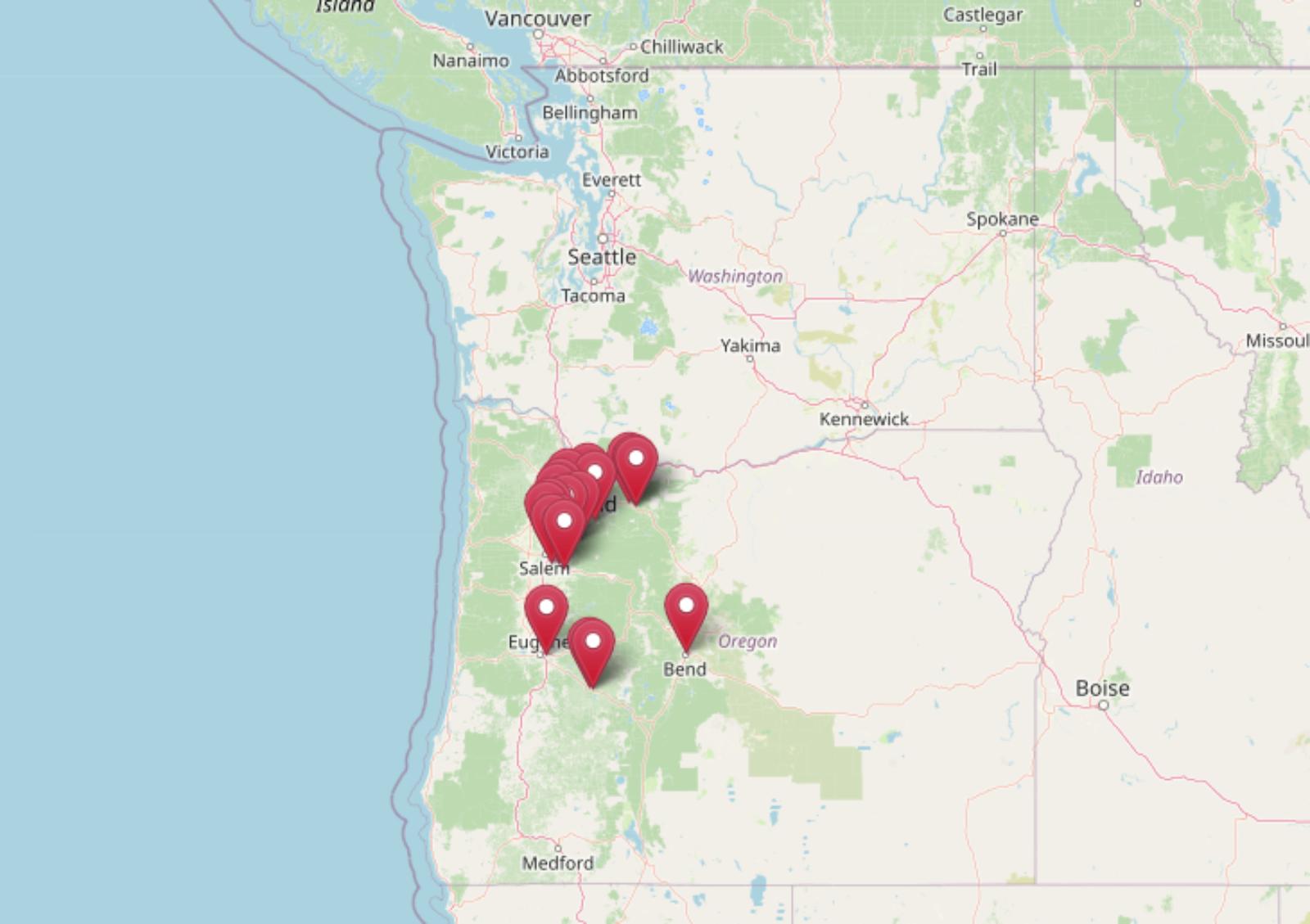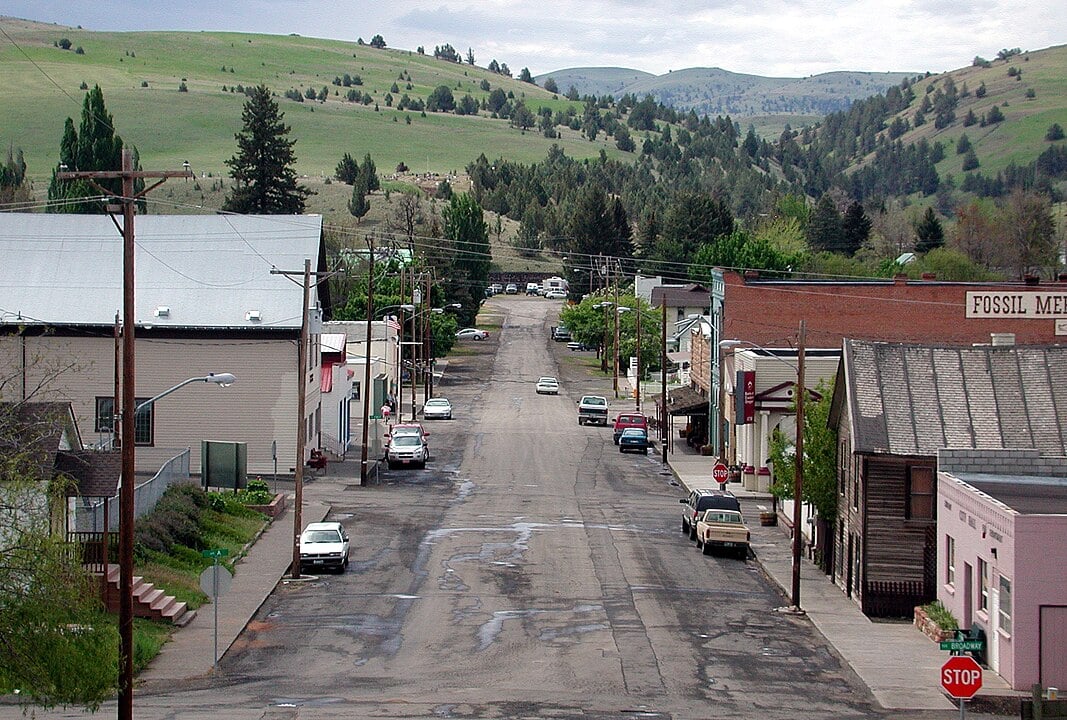
There’s no grand welcome sign when you cross into Warner Valley. No curated trail of antique shops or branded farm stands. What you’ll find instead are long corridors of silence, occasional cattle grids, and the low hum of wind moving through fence wire. Southeastern Oregon’s high desert doesn’t go out of its way to be seen—and that’s the appeal.
Places like Plush and Wagontire aren’t built for show. They’re spare, utilitarian, and remarkably still. Locals wave from pickups without slowing down. Businesses open when they open. The weather runs the schedule. But in that looseness, there’s a kind of freedom that’s harder to come by elsewhere.
These towns—some barely towns anymore—have held on in ways both stubborn and quiet. Some are built around ranching, others around the memory of industries that moved on. In Silver Lake, the cafe doubles as the local bulletin board. In Adel, the gas pump may or may not be working—but the view never breaks.
This list doesn’t promise amenities or itineraries. It promises space. Ten towns that haven’t traded their identity for convenience. Ten places where the sky is wide, the stories are sparse, and the quiet isn’t a gimmick—it’s just what happens when there’s nothing left to prove.
10. Wagontire: Mysteries of a High Desert Ghost Town

Once a small pit stop along U.S. Route 395, Wagontire now stands as a testament to times gone by, with a population that has dwindled to near zero. This abandoned ghost town offers an eerie yet fascinating glimpse into Oregon’s past, complete with a deserted motel and gas station that echo stories of travelers long since passed.
Though there aren’t traditional activities to do, the desolation itself draws photographers and history enthusiasts intrigued by its rustic remains. The town’s main industry vanished with its residents, leaving behind structures that have withstood the harsh desert climate. Wagontire’s seclusion is anchored in its remote location amid expansive sagebrush plains, with the silence only interrupted by the whispering wind.
Where is Wagontire?

Wagontire is located in Oregon’s Harney County, approximately 60 miles south of Burns along U.S. Route 395. Its isolation is profound, surrounded by miles of uninhabited high desert terrain, making it one of the most secluded spots near Warner Valley. The lack of nearby services and the vast stretches of open road contribute to its ghost town status. Travelers can reach Wagontire by car, but should be prepared for minimal amenities and the striking quiet that characterizes this forgotten corner of Oregon.
9. Silver Lake: Serenity Amidst Natural Splendor

With a population hovering around 150 residents, Silver Lake is a peaceful community that embodies small-town charm. Visitors can enjoy bird watching at the nearby Silver Lake Marsh, a haven for waterfowl and wildlife enthusiasts. The town serves primarily agricultural purposes, with ranching being the main industry supporting its tight-knit community.
Silver Lake’s seclusion is accentuated by its vast surrounding landscapes and minimal tourist traffic, offering a tranquil escape for those seeking a slower pace of life.
Where is Silver Lake?

Silver Lake is situated in Lake County, about 35 miles northwest of the town of Lakeview, near the edge of Warner Valley. Its remote location along Oregon Route 31 provides a gateway to the state’s outback, far from bustling urban centers. The town’s distance from major highways and cities preserves its serenity, making it a hidden gem for travelers venturing off the beaten path. Reaching Silver Lake involves a scenic drive through Oregon’s high desert, rewarding visitors with solitude and natural beauty upon arrival.
8. Cedarville: Quiet Escape in Surprise Valley

Although just outside Warner Valley, Cedarville offers a quaint retreat with a population of around 500. The town is known for its picturesque landscapes, hot springs, and proximity to the Warner Mountains, making it a delightful spot for hiking and soaking in natural mineral waters.
Agriculture and small-scale tourism support the local economy, but the area remains largely undeveloped. Cedarville’s seclusion stems from its location in the Surprise Valley, enveloped by vast open spaces and a calming atmosphere that invites relaxation.
Where is Cedarville?

Cedarville is located in Modoc County, California, just south of the Oregon border and east of the Warner Mountains. This positioning near Warner Valley allows easy access to its scenic wonders while maintaining a distinct sense of remoteness. The town is accessible via State Route 299, yet its distance from major urban centers ensures a peaceful environment. The journey to Cedarville is marked by expansive vistas and quiet roads, making it a perfect destination for those seeking solitude.
7. Fort Bidwell: Historic Frontier Town Beyond the Valley

Fort Bidwell is a small community with a population of about 200, rich in history dating back to its days as a military outpost. Visitors can explore remnants of the old fort and enjoy the surrounding natural beauty, including nearby lakes and hiking trails. The primary industries are ranching and agriculture, which sustain the local economy. Its secluded nature is due to its remote location and the preservation of its historical sites, offering a quiet atmosphere far removed from the rush of modern life.
Where is Fort Bidwell?

Located in the northeastern corner of California’s Modoc County, Fort Bidwell sits just beyond Warner Valley. Its proximity to the state line makes it a gateway to both California and Oregon’s scenic regions. The town is reachable by county roads, with the nearest major highway miles away, enhancing its sense of isolation. The peaceful drive through rural landscapes adds to the feeling of stepping back in time upon arrival, making Fort Bidwell a unique and tranquil destination.
6. Paisley: Rustic Appeal and Rich History

Paisley, home to approximately 250 residents, exudes rustic charm with its historic buildings and close-knit community. Outdoor enthusiasts can explore the nearby Paisley Caves, which hold significant archaeological importance, or enjoy fishing along the Chewaucan River.
The town’s economy revolves around ranching and farming, keeping it deeply connected to the land. Paisley’s seclusion is due to its setting amid Oregon’s high desert, away from bustling tourist spots, offering a peaceful retreat with a touch of historical intrigue.
Where is Paisley?

Paisley is located in Lake County, along Oregon Route 31, north of Lakeview and near the western edge of Warner Valley. Its distance from major cities and highways contributes to its tranquil atmosphere. The surrounding landscape of rolling hills and open fields enhances the sense of seclusion. Visitors can reach Paisley via a scenic drive through sparsely populated areas, making the journey as serene as the destination itself.
5. Summer Lake: Tranquil Retreat Near Warner Valley

With a small population of around 90, Summer Lake is a tranquil haven known for its natural hot springs and bird-watching opportunities at the Summer Lake Wildlife Area. The town attracts those looking to unwind in its soothing waters or observe migratory birds in their natural habitat.
Local industries include agriculture and eco-tourism centered around its natural amenities. Summer Lake’s seclusion is amplified by its sparse population and the expansive high desert that surrounds it, offering visitors a peaceful escape from everyday life.
Where is Summer Lake?

Situated in northern Lake County along Oregon Route 31, Summer Lake lies to the northwest of Warner Valley. The area’s remoteness is underscored by the vast stretches of open land and minimal development. Accessing Summer Lake involves a drive through the scenic Oregon Outback Scenic Byway, enhancing the feeling of seclusion upon arrival. The town’s isolation makes it an ideal spot for relaxation and reconnecting with nature.
4. New Pine Creek: The Border Town with Dual Charm

New Pine Creek straddles the Oregon-California border, with a combined population of around 120 residents. This unique positioning offers a blend of cultures and scenic views of Goose Lake and the surrounding mountains. Activities include exploring local antique shops and enjoying outdoor recreation in the nearby Modoc National Forest.
The main industries are agriculture and small-scale retail, serving both locals and visitors. The town’s seclusion is due to its border location and the tranquil environment provided by the adjacent natural landscapes.
Where is New Pine Creek?

Located at the southern tip of Lake County, New Pine Creek sits right on the border between Oregon and California, near the southeastern edge of Warner Valley. Its remote setting is enhanced by the surrounding forests and proximity to Goose Lake. Travelers can reach New Pine Creek via U.S. Route 395, but its distance from large cities ensures a quiet atmosphere. The combination of border-town charm and natural beauty makes it a secluded spot worth visiting.
3. Lakeview: Gateway Town with Panoramic Valley Views

Lakeview, known as the “Tallest Town in Oregon,” has a population of about 2,300 and serves as the main hub of Lake County. Visitors can enjoy panoramic views of Warner Valley from the nearby hills, relax in the Old Perpetual Geyser Hot Springs, or explore local museums.
The town’s economy is based on timber, agriculture, and tourism, providing services to the surrounding rural communities. Despite being larger than its neighbors, Lakeview’s remote location and surrounding natural beauty give it a secluded feel, making it a peaceful gateway to the valley.
Where is Lakeview?

Lakeview is located in south-central Oregon, at the intersection of U.S. Route 395 and Oregon Route 140, near the western edge of Warner Valley. Its distance from major urban centers contributes to its seclusion, with the nearest city, Klamath Falls, over 90 miles away. The town is nestled between the Warner Mountains and the Fremont–Winema National Forest, enhancing its scenic isolation. Accessing Lakeview involves traveling through expansive high desert landscapes, setting the tone for a tranquil visit.
2. Adel: A Peaceful Oasis in Oregon’s High Desert

Adel is a tiny community with an estimated population of 75 people, offering a peaceful oasis amid the high desert. Visitors can immerse themselves in the quiet charm of the town, enjoy hunting and fishing in the nearby areas, or visit the local Adel Store and Café, which serves as the community’s social hub.
Ranching is the mainstay of Adel’s economy, reflecting a lifestyle deeply connected to the land. The town’s seclusion is a result of its remote location and the vast open spaces that surround it, providing a serene environment away from the hustle and bustle.
Where is Adel?

Adel is situated in eastern Lake County along Oregon Route 140, nestled in the heart of Warner Valley. Its isolation is accentuated by the rugged terrain and minimal development in the area. The town is accessible by road but lies far from any major highways or cities, reinforcing its secluded nature. The journey to Adel takes travelers through picturesque landscapes, with the remoteness offering a true escape into Oregon’s high desert tranquility.
1. Plush: The Heart of Warner Valley’s Ranching Heritage

Plush is a small unincorporated community with a population of about 50 residents, embodying the ranching heritage of Warner Valley. Visitors can search for Oregon sunstones at the nearby Sunstone Public Collection Area, the state’s official gemstone, or explore the Hart Mountain National Antelope Refuge.
Ranching is the lifeblood of Plush, with vast open ranges supporting cattle and sheep operations. The town’s seclusion comes from its remote high desert location, limited population, and the sweeping landscapes that define this part of Oregon.
Where is Plush?

Located in Lake County, Plush lies along a county road east of Oregon Route 140, deep within the Warner Valley. The town’s remote setting is further emphasized by the surrounding Hart Mountain and the expanse of the Warner Wetlands. Access to Plush involves driving through miles of unspoiled high desert terrain, with the nearest significant town being Lakeview, over 35 miles away. The isolation offers a unique sense of peace and a chance to experience the untouched beauty of Oregon’s outback.






